
Amalfi Coast Tour • Positano • Ravello • Paestum
Map: Getting Around the Amalfi Coast
With its stunning scenery, hill- and harbor-hugging towns, and historic ruins, Amalfi is Italy’s coast with the most. The breathtaking trip from Sorrento to Salerno is one of the world’s great bus or taxi rides. It will leave your mouth open and your camera’s memory card full. You’ll gain respect for the 19th-century Italian engineers who built the roads—and even more for the 21st-century drivers who squeeze past each other here daily. Cantilevered garages, hotels, and villas cling to the vertical terrain, and beautiful but out-of-reach coves tease from far below. As you hyperventilate, notice how the Mediterranean, a sheer 500-foot drop below, really twinkles. All this beautiful scenery apparently inspires local Romeos and Juliets, with the latex evidence of late-night romantic encounters littering the roadside turnouts. Over the centuries, the spectacular scenery and climate have been a siren call for the rich and famous, luring Roman Emperor Tiberius, Richard Wagner, Sophia Loren, Gore Vidal, and others to the Amalfi Coast’s special brand of la dolce vita.
The two main Amalfi Coast towns (Positano and Amalfi) are pretty, but they’re also touristy, congested, and overpriced. (Many visitors prefer side-tripping in from Sorrento.) Most beaches here are private, pebbly, and expensive. Check and understand your bills in this greedy region.
In Paestum, farther south, you can see one of the world’s best collections of 2,500-year-old Greek temples, a worthwhile museum with artifacts from the site, and the remains of a Roman town.
The Amalfi Coast is one of those places with a “must see” reputation. Staggeringly picturesque and maddeningly touristy, it can be both rewarding and frustrating. As an antidote to intense Naples, its the perfect place for a romantic break—if done right and if you can afford it. These towns are the big three sights of the Amalfi Coast: Positano is like a living Gucci ad and has good overnight options; Amalfi evokes a day when small towns with big fleets were powerhouses on the Mediterranean; and Ravello is fun for that tramp-in-a-palace feeling.
On a quick visit, use Sorrento (see previous chapter) as your home base and do the Amalfi Coast as a day trip (skipping Paestum). But for a small-town vacation from your vacation, spend a few more days on the coast, sleeping in Positano.
Trying to decide between staying in Sorrento or Positano? Sorrento is larger, with useful services and the best transportation connections and accommodations. Tiny Positano is more touristy, but also more chic and picturesque, with a decent beach.
Naples or Paestum can also work as a base for an Amalfi Coast day trip, if you get an early start and the timetables align. From Naples, you have two options by public transport: train to Salerno, then bus (or boat) to Amalfi town; or, Circumvesuviana train to Sorrento, then bus to Positano and/or Amalfi. (You can go out one way and return the other.) From Paestum, you can take the train to Salerno, then the bus (or boat) to Amalfi or Positano.
The real thrill here is the scenic drive between Sorrento and Salerno. The stretch from Positano to Amalfi is the best. This is treacherous stuff—even if you have a car, you may want to take the bus or hire a driver. Brave souls enjoy seeing the coast by scooter or motorbike (rent in Sorrento).

Next, I’ve outlined your options by bus, boat, and taxi. Many travelers do the Amalfi Coast as a round-trip by bus, but a good strategy is to go one way by land and return by boat. For example, consider taking the bus along the coast to Positano and/or Amalfi, then catching the ferry back. Ferries run less often in spring and fall, and some don’t run at all off-season (mid-Oct-mid-April). Boats don’t run in stormy weather at any time of year. If boats aren’t running between Amalfi and Sorrento, you can change boats in Capri.
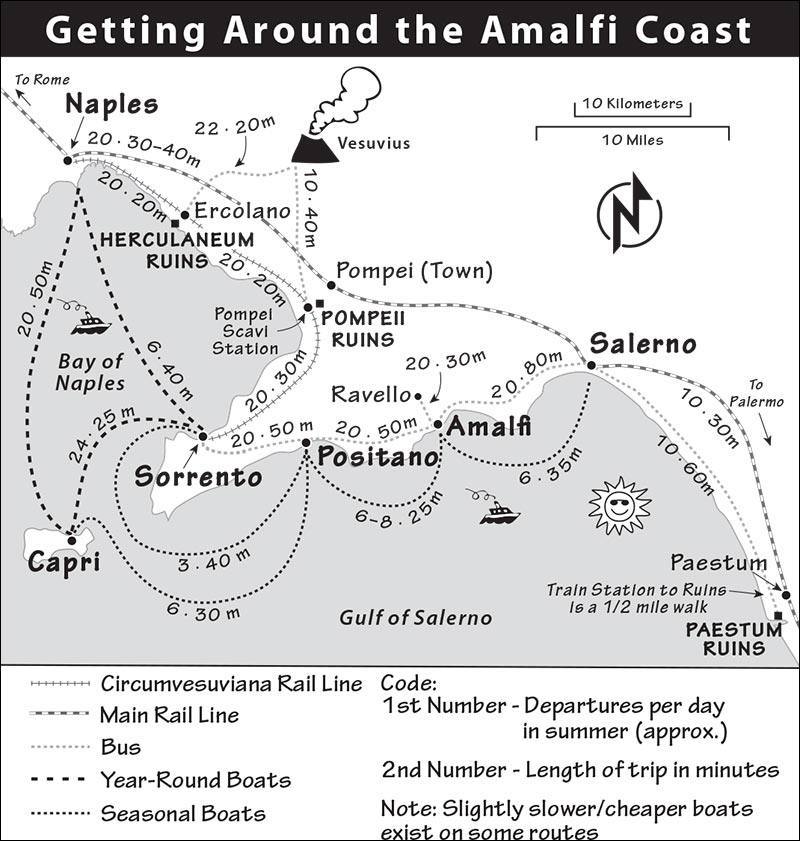
Looking for exercise? Consider an Amalfi Coast hike (see “Hikes” in the Amalfi Town section, later in this chapter). Numerous trails connect the main coastal towns with villages on the hills. Get a good map before you venture out.
SITA buses from Sorrento to Amalfi, via Positano, are the most common, inexpensive way to see the coast (for schedules, see www.sitabus.it or—easier to read—www.positano.com). In Sorrento, buses depart from in front of the train station beginning at 6:30; from 8:30 they run roughly every half hour until 17:00, then hourly until 22:00 in summer, until 20:00 in winter (50 minutes to Positano; another 50 minutes to Amalfi). To reach Ravello (the hill town beyond Amalfi) or Salerno (at the far end of the coast), transfer in Amalfi.
Individual tickets are inexpensive (€2-4). All rides are covered by the 24-hour Costiera SITA Sud pass (€10), which may not save you money but does save time buying tickets. Tickets are sold at tobacco shops and newsstands, not by drivers.
Line up under the Bus Stop SITA sign across from the train station (10 steps down, look for the sales desk under an umbrella). When checking the schedule, note that Giornaliero (G) means daily, Scolastico (S) means school bus, Feriale (F) denotes Monday-Saturday, and Festivo (H) is for Sundays and holidays.
Leaving Sorrento, grab a seat on the right for the best views. If you return by bus, it’s fun to sit directly behind the driver for a box seat with a view over the twisting hairpin action. Sitting toward the front will also help minimize carsickness.
Avoiding Crowded Buses: Amalfi Coast public buses are routinely unable to handle demand during summer months and holidays (perhaps because the fares are so cheap). Generally, if you don’t get on one bus, you’re well-positioned to catch the next one. From Sorrento, aim to leave on the 8:30 bus at the latest—earlier if possible. Departures between 9:00 and 11:00 can be frustratingly crowded.
Note that an eight-seater minibus and driver costs about €300 for the day: If you can organize a small group, €40 per person is a very good deal. (For options, see “By Taxi,” later.)
When to Stop in Positano: Summer congestion can be so bad—particularly in July and August—that some Amalfi-Sorrento buses don’t even stop in Positano (because they fill up in Amalfi). Those trying to get back from Positano to Sorrento are stuck taking an extortionist taxi or hopping a boat...if one’s running. When day-tripping from Sorrento to Amalfi, it’s safest to make your Positano stop on the outbound leg, then come straight home from Amalfi, where the bus originates. Or, you can consider the hop-on, hop-off bus as an alternative.
CitySightseeing’s bright red hop-on, hop-off buses travel from Sorrento to Positano to Amalfi and back. While more expensive than public buses, they can be much less crowded and come with a recorded commentary. You’ll pay €10 for your outgoing ride (buy tickets onboard), then €6 for the return trip (on the same day). Buses run hourly all day April-October, leaving the Sorrento train station at :45 past each hour starting at 8:45. Return trips from Amalfi leave at :15 past each hour (until 19:15—confirm locally). The trip takes about 1.5 hours, with a stop in Positano each way. Check out www.city-sightseeing.it (but don’t be confused by their “two bays” tour of the Cape of Sorrento, which is not worth considering).
CitySightseeing also offers a second service on a smaller bus from Amalfi to Ravello. Tickets are €5 each way (buy onboard from driver). The trip takes 30 minutes, with departures at :15 and :45 past the hour beginning at 9:45. The last service of the day is between 16:00 and 17:00, so plan to leave Ravello by then. If you miss the last bus, a taxi back to Amalfi is about €50.
A few passenger boats per day link Positano and Amalfi with Sorrento, Capri, and Salerno (generally April-Oct only). The last daily departure can be as early as midafternoon and is never much later than 18:00. Check schedules carefully: Frequency varies from month to month, and boats may be cancelled in bad weather (especially at Positano, where there’s no real pier). The companies operating each route change frequently, compete for passengers, and usually claim to know nothing about their rivals’ services. The best sources for timetables are www.capritourism.com (under “Shipping Timetable”) and www.positano.com (under “Ferry Schedules”). You can also check individual company websites (such as www.travelmar.it, www.alicost.it, and www.gescab.it). It’s smartest to confirm locally: The region’s TIs hand out flyers with current schedules. Buy tickets on the dock. For a summary of sample routes, frequencies, and travel times, see the “Getting Around the Amalfi Coast” map.
If you’re going to Capri from Positano or Amalfi, save time and money by finding a boat that goes directly to the Blue Grotto (rather than dropping you in the port in Capri to catch another boat from there). Here’s another useful trick: If no boats are going directly between Sorrento and Positano/Amalfi, you can usually still connect the two sides of the peninsula via Capri.
Given the hairy driving, impossible parking, crowded public buses, and potential fun, you might consider splurging to hire your own car and driver for your Amalfi day.
The Monetti family car-and-driver service—Raffaele, daughter Carolina, cousin Tony, and Gianpaolo—have taken excellent care of my readers’ transit needs for decades. Sample trips and rates: all-day Amalfi Coast (Positano, Amalfi, Ravello), 8 hours, €300; Amalfi Coast and Paestum, 10 hours, €450; transfer to Naples airport or train station to Sorrento, €130. These prices are for up to three people; you’ll pay more for a larger eight-seater van. Though based in Sorrento, they also do trips from Naples and longer excursions to Matera. Payment is cash only (as with most of the car services listed). Their reservation system is simple and reliable (Raffaele’s mobile 335-602-9158 or 338-946-2860, “office” run by his English-speaking Finnish wife, Susanna, www.monettitaxi17.it, monettitaxi17@libero.it). Don’t just hop into any taxi claiming to be a Monetti—call first. If you get into any kind of serious jam in the area, you can call Raffaele for help.
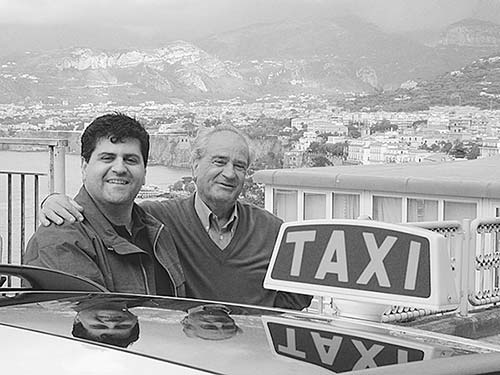
Francesco del Pizzo is another smooth and honest Sorrento-based driver. A classy man who speaks English well, Francesco enjoys explaining things as he drives (9 hours or so in a car with up to 4 passengers, €300; up to 8 passengers in a minibus, €340; mobile 333-238-4144, francescodelpizzo@yahoo.it).
Anthony Buonocore, an Amalfi native, specializes in cruise shore excursions, as well as transfers anywhere in the region in his eight-person Mercedes van (rates vary, special deals for early booking and in low season, tel. 349-441-0336, www.amalfitransfer.com, buonocoreanthony@yahoo.it).
Rides Only: If you’re hiring a cabbie off the street for a ride and not a tour, here are sample fares from Sorrento to Positano: up to four people one-way for about €80 in a car, or up to six people for €90 in a minibus. Figure on paying 50 percent more to Amalfi. While taxis must use a meter within a city, a fixed rate is OK elsewhere. Negotiate—ask about a round-trip.
While hiring your own driver is convenient, it’s also expensive. To bring the cost down, split the trip—and the bill—with other travelers using this book. Naples-based Mondo Guide offers a nine-hour minibus trip that departs from Sorrento and heads down the Amalfi Coast, with brief stops in Positano, Amalfi, and Ravello, before returning to Sorrento (€55/person). They also offer Rick Steves readers shared tours in Pompeii and Naples. For details, see here.
The wildly scenic Amalfi Coast drive from Sorrento to Salerno, worth ▲▲▲, is one of the all-time great white-knuckle rides, whether you tackle it by bus, taxi, or shared minibus.
Gasp from the right side of the car or bus as you go out and from the left as you return to Sorrento. (Those on the wrong side really miss out.) Traffic is so heavy that private tour buses are only allowed to go in one direction (southbound from Sorrento). Summer traffic is infuriating. Fluorescent-vested police are posted at tough bends during peak hours to help fold in side-view mirrors and keep things moving. Here’s a loose, self-guided tour of what you’re seeing as you travel from west to east.
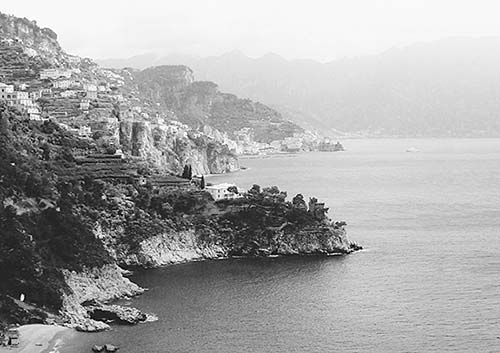
 Self-Guided Tour: Leaving Sorrento, the road winds up into the hills past lemon groves and hidden houses. The gray-green trees are olives. (Notice the green nets slung around the trunks; these are unfurled in October and November, when the ripe olives drop naturally, for an easy self-harvest.) Dark, green-leafed trees planted in dense groves are the source of the region’s lemons (many destined to become limoncello liqueur) and big, fat citrons (cedri, mostly used for marmalade). The black nets over the orange and lemon groves create a greenhouse effect, trapping warmth and humidity for maximum tastiness, while offering protection from extreme weather (preserving the peels used for limoncello).
Self-Guided Tour: Leaving Sorrento, the road winds up into the hills past lemon groves and hidden houses. The gray-green trees are olives. (Notice the green nets slung around the trunks; these are unfurled in October and November, when the ripe olives drop naturally, for an easy self-harvest.) Dark, green-leafed trees planted in dense groves are the source of the region’s lemons (many destined to become limoncello liqueur) and big, fat citrons (cedri, mostly used for marmalade). The black nets over the orange and lemon groves create a greenhouse effect, trapping warmth and humidity for maximum tastiness, while offering protection from extreme weather (preserving the peels used for limoncello).
Atop the ridge outside Sorrento, look to your right: The two small islands are the Li Galli Islands, where some say the sirens in Homer’s Odyssey lived. The largest of these islands was once owned by the famed ballet dancer Rudolf Nureyev; it’s now a luxury residence, rented to wealthy visitors for upward of $100,000 per week (bring your own yacht or arrive by helicopter).
When Nureyev bought the island, the only building standing was the stony watchtower—the first of many you’ll see all along the coast. These were strategically placed within sight of one another so that a relay of rooftop bonfires could quickly spread word of a pirate attack.
The limestone cliffs that plunge into the sea were traversed by a hand-carved trail that became a modern road in the mid-19th century. Fruit stands sell produce from farms and orchards just over the hill. Limestone absorbs the heat and rainwater, making this south-facing coastline a fertile suntrap, with temperatures as much as 10 degrees higher than in nearby Sorrento. The chalky, reflective limestone, which extends below the surface, accounts for the uniquely colorful blues and greens of the water. With the favorable climate, bougainvillea, geraniums, oleander, and wisteria grow like weeds here in the summer. Notice the nets pulled tight against the cliffs—they’re designed to catch rocks that often tumble loose after heavy rains.
The dramatic, exotic-looking town of Positano is the main stop along the coast. The town is built on a series of man-made terraces, which were carefully carved out of the steep rock, then filled with fertile soil carried here from Sorrento on the backs of donkeys. You can read the history of the region in Positano’s rooftops—a mix of Roman-style red terra-cotta tiles and white domes inspired by the Saracens (see sidebar).
If you’re getting off here, stay on through the first stop by the round-domed yellow church (Chiesa Nova), which is a very long walk above town. Instead, get off at the second stop, Sponda, then head downhill toward the start of my self-guided Positano Walk (later in this chapter). Sponda is also the best place to catch the onward bus to Amalfi. If you’re coming on a smaller minibus, you’ll twist all the way down—seemingly going in circles—to the start of the walk.
Just south of Positano, St. Peter’s Hotel (Il San Pietro di Positano, camouflaged below the tiny St. Peter’s church) is just about the poshest stop on the coast. In the adjacent gorge, notice the hotel’s terraced gardens (where produce is grown for their restaurant) above an elevator-accessible beach and dock.
Just around the bend, Praiano comes into view. Less ritzy or charming than Positano or Amalfi, it’s notable for its huge Cathedral of San Gennaro, with a characteristic majolica-tiled roof and dome—a reminder of this region’s respected ceramics industry. In spindly Praiano, most of the homes are accessible only by tiny footpaths and staircases. Near the end of town, just before the big tunnel, watch on the left for the big presepe (manger scene) embedded into the cliff face. This Praiano-in-miniature was carved by one local man over several decades. At Christmastime, each house is filled with little figures and twinkle lights.
Just past the tunnel, look below and on the right to see another Saracen watchtower. (Yet another caps the little point on the horizon.)
A bit farther along, look down to see the fishing hamlet of Marina di Praia tucked into the gorge (furore) between two tunnels. If you’re driving—or being driven—consider a detour down here for a coffee break or meal. This serene, tidy nook has its own little pebbly beach with great views of the stout bluffs and watchtower that hem it in. A seafront walkway curls around the bluff all the way to the tower.
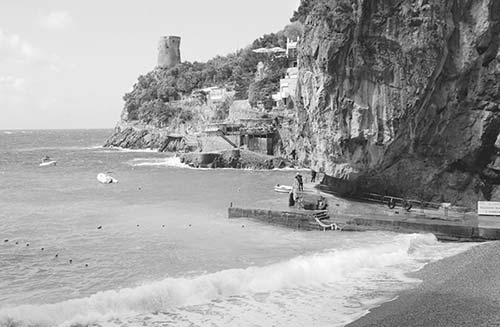
Just after going through the next tunnel, watch for a jagged rock formation on its own little pedestal. Locals see the face of the Virgin Mary in this natural feature and say that she’s holding a flower (the tree growing out to the right). Also notice several caged, cantilevered parking pads sticking out from the road. This stretch of coastline is popular for long-term villa rentals—Italians who want to really settle in to Amalfi life.
Look down and left for the blink-or-you’ll-miss-it fishing village that’s aptly named Fiordo (“fjord”), filling yet another gorge. You’ll see humble homes burrowed into the cliff face, tucked so far into the gorge that they’re entirely in shadow for much of the year. Today these are rented out to vacationers; the postage-stamp beach is uncrowded and inviting.
After the next tunnel, in the following hamlet, keep an eye out for donkeys with big baskets on their backs—the only way to make heavy deliveries to homes high in the rocky hills.
Soon you’ll pass the big-for-Amalfi parking lot of the Grotta dello Smeraldo (“Emerald Grotto”), a cheesy roadside attraction that wrings the most it can out of a pretty, seawater-filled cave. Passing tourists park here and pay €5 to take an elevator down to sea level, pile into big rowboats, and get paddled around a genuinely impressive cavern while the boatman imparts sparse factoids. Unless you’ve got time to kill, skip it.
Now you’re approaching what might be the most dramatic watchtower on the coast, perched atop a near-island. This tower guarded the harbor of the Amalfi navy until the fleet was destroyed in 1343 by a tsunami caused by an earthquake, which also led to Amalfi’s decline (it was once one of Italy’s leading powers).
Around the next bend you’re treated to stunning views of the coastline’s namesake town—Amalfi. The white villa sitting on the low point between here and there (with another watchtower at its tip) once belonged to Sophia Loren. Now look up to the very top of the steep, steep cliffs overhead. The hulking former Monastery of Santa Rosa occupies this prime territory. Locals proudly explain that the sfogliatella dessert so beloved throughout the Campania region was first created at this monastery. (Today it’s a luxury resort, where you can pay a premium to sleep in a tight little former monk’s cell.)

The most striking stretch of coastline ends where the bus pulls to a halt—at the end of the line, the waterfront of Amalfi town. Spend some time enjoying this once-powerful, now-pleasant city, with its fine cathedral, fascinating paper museum, and fun-to-explore tangle of lanes (covered later in this chapter).
From Amalfi, you can transfer to another bus to head up to Ravello (described later), capping a cliff just beyond Amalfi, or onward to the big city of Salerno. Alternatively, buses and boats take you back to Positano and Sorrento.
If you’re continuing the trip southward (on the bus to Salerno or Ravello), look up to the left as you leave Amalfi—the white house that clings to a cliff (Villa Rondinaia) was home for many years to writer Gore Vidal. Soon you’ll pass through the low-impact, pleasantly untouristy town of Atrani (described later in this chapter). From here, you’ll enjoy fine (though slightly less thrilling) scenery all the way to Salerno.
Specializing in scenery and sand, the easygoing town of Positano hangs halfway between Sorrento and Amalfi town on the most spectacular stretch of the coast. According to legend, the Greek god Poseidon created Positano for Pasitea, a nymph he lusted after. History says the town was founded when ancient Greeks at Paestum decided to move out of the swamp (to escape the malaria carried by its mosquitoes).
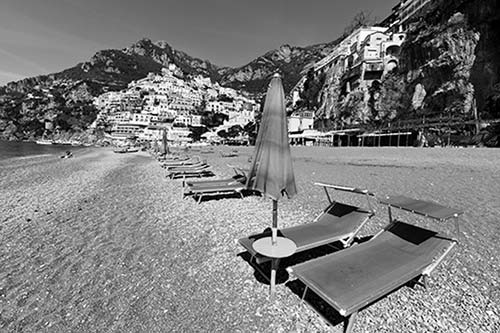
In antiquity, Positano was famed for its bold sailors and hearty fleet. But after a big 1343 tsunami and the pirate raids of the Middle Ages, its wealth and power declined. It flourished again as a favorite under the Bourbon royal family in the 1700s, when many of its fine mansions were built. Until the late 1800s, the only access was by donkey path or by sea. In the 20th century, Positano became a haven for artists and writers escaping Communist Russia and Nazi Germany. In 1953, American writer John Steinbeck’s essay on the town popularized Positano among tourists, and soon after it became a trendy Riviera stop. That was when the town gave the world “Moda Positano”—a leisurely dolce vita lifestyle of walking barefoot; wearing bright, happy, colorful clothes; and sporting skimpy bikinis.
Today, the village, a breathtaking ▲▲▲ sight from a distance, is a pleasant gathering of cafés and expensive stores draped over an almost comically steep hillside. Terraced gardens and historic houses cascade downhill to a stately cathedral and a broad, pebbly beach. Positano is famous for its fashions—and 90 percent of its shops are women’s clothing boutiques (linen is a particularly popular item).
The “skyline” looks like it did a century ago. Notice the town’s characteristic Saracen-inspired rooftop domes. Filled with sand, these provide low-tech insulation—to help buildings, in the days before central air, stay cool in summer and warm in winter. Traditionally, they were painted white in summer and black in winter.
For decades, it’s been practically impossible to get a building permit in Positano. Landowners who want to renovate can’t make external changes. Endless staircases are a way of life for the hardy locals. Only one street in Positano allows motorized traffic; the rest are narrow pedestrian lanes. While Positano has 4,000 residents, an average of 12,000 tourists visit daily from Easter through October. But because hotels don’t take large groups (bus access is too difficult), this town—unlike Sorrento—has been spared the worst ravages of big-bus tourism. In winter, hotels shut down and the town once again belongs to the locals.
Consider seeing Positano as a day trip from Sorrento: Take the bus out and the afternoon ferry home, but be sure to check boat schedules when you arrive—the last ferry often leaves before 18:00 and doesn’t always run in spring and fall. Or spend the night to enjoy the magic of Positano after dark. The town has a local flavor at night, when the grown-ups stroll and the kids play soccer on the church porch.
Squished into a ravine, with narrow alleys that cascade down to the harbor, Positano requires you to stroll, whether you’re going up or heading down. The center of town has no main square (unless you count the beach). There’s little to do here but eat, window shop, and enjoy the beach and views...hence the town’s popularity.
Tourist Information: The TI is a block from the beach, in the red building a half-block beyond the bottom of the church steps (Mon-Sat 9:00-19:00, Sun until 14:00, shorter hours off-season, Via Regina Giovanna 13, tel. 089-875-067, www.aziendaturismopositano.it).
Local Guide: Positano native Lucia Ferrara (a.k.a. “Zia Lucy”) brings substance to this glitzy town. During the day, she leads guided hiking tours, including the “Path of the Gods” above Amalfi town (up to 10 people, about 4 miles, 5 hours, €55/person, includes picnic). In the evening, if there’s enough demand, she leads a Positano town walking tour (3 hours, departs at 17:00, €30/person). She also offers food tours (mobile 339-272-0971, www.zialucy.com).

The main coastal highway winds above the town. Regional SITA buses stop at two scheduled bus stops located at either end of town: Chiesa Nuova (at Bar Internazionale, near the Sorrento end of town; use this one only if you’re staying at Brikette Hostel) and Sponda (nearer Amalfi town). Although both stops are near roads leading downhill through the town to the beach, Sponda is closer and less steep; from this stop, it’s a scenic 20-minute downhill stroll/shop/munch to the beach (and TI).
Neither bus stop has easy baggage storage. Positano does have porter services: A porter can meet you at the Sponda bus stop and watch your bags for €5 apiece—but you have to call them in advance (try Positano Porter, tel. 089-875-310). Another option is to get off at Chiesa Nuova and head for the Brikette Hostel, which offers day privileges for €10, including luggage storage, Wi-Fi, and showers. A last resort is to get off at the Sponda stop and roll your bags all the way down to Piazza dei Mulini, where the porters tend to hang out.
If you’re catching the SITA bus from Positano, be aware that it may leave from the Sponda stop five minutes before the printed departure time. There’s simply no room for the bus to wait, so in case the driver is early, you should be, too. Buy tickets at the tobacco shop in the town center (on Piazza dei Mulini).
If the walk up to the stop is too tough, take one of the dizzy little shuttle buses (marked Interno Positano), which constantly loop through Positano, connecting the lower town with the highway’s two bus stops (2/hour, €1.30 at tobacco shop on Piazza dei Mulini, €1.80 on board, catch it at the convenient stop at the corner of Via Colombo and Via dei Mulini, heads up to Sponda). Collina Bakery, located off Piazza dei Mulini (as close as cars, taxis, and the shuttle bus can get to the beach), is just across from the shuttle bus stop, with a fine, breezy terrace to enjoy while you wait.
Coming from the ferry, you can give luggage to one of the porter services or lug everything uphill yourself. Follow crowds up wide stairs to the large church, then follow the trellis to Piazza dei Mulini. You’ll be doing the reverse of my Positano Walk (described next).
Drivers must go with the one-way flow, entering the town only at the Chiesa Nuova bus stop (closest to Sorrento) and exiting at Sponda (a 20-minute one-way loop). Driving is a headache here. Parking is even worse.
While there’s no real sightseeing in Positano, this short, self-guided stroll downhill will help you get your bearings from top to bottom.
• Start at...
Piazza dei Mulini: This is the upper-town meeting point—as close to the beach as vehicles can get—and the lower stop for the little shuttle bus. Collina Bakery is a local hangout (in this small town, gossiping is a big pastime). Older people tend to gather inside, while the younger crowd congregates on the wisteria-draped terrace across the street.
Dip into the little yellow Church of the Holy Rosary (by the road), with a serene 12th-century interior. Up front, to the right of the main altar, find the delicately carved fragment of a Roman sarcophagus (first century BC). Positano sits upon the site of a sprawling Roman villa, and we’ll see a few reminders of that age as we walk.
At the top of the town lane (across from the church) is a popular granita stand, where the family has been following the same secret lemon slush recipe for generations.
Now continue downhill into town, passing a variety of shops—many selling linen and ceramics. These industries boomed when tourists discovered Positano. The beach-inspired Moda Positano fashion label was born as a break from the rigid dress code of the 1950s. (For tips on shopping for linen, see “Shopping,” under “Sights in Positano,” later). Positano also considers itself an artists’ colony, and you’ll see many galleries featuring the work of area artists.
• Wander downhill to the “fork” in the road (stairs to the left, road to the right). You’ve reached...
Midtown: At Enoteca Cuomo (#3), butchers Pasquale and Rosario stock fine local red wines and are happy to explain their virtues. They also make homemade sausages, salami, and panini—good for a quick lunch. The smaller set of stairs leads to the recommended Delicatessen grocery, where Emilia can fix you a good picnic.
La Zagara (across the lane from the steps, at #10, with a leafy terrace) is a pricey pastry shop by day and a cocktail bar by night. Tempting pastries such as the rum-drenched babà (a southern Italian favorite) fill the window display. A bit farther downhill, Brunella (on the right, at #24) is respected for traditional quality, and Positano-made linens.
Across the street, the ritzy Hotel Palazzo Murat fills what was once a grand Benedictine monastery. Napoleon, fearing the power of the Church, had many such monasteries closed during his rule here. This one became a private palace, named for his brother-in-law, who was briefly the King of Naples. Step into the plush courtyard to enjoy the scene, with great views of the cathedral’s majolica-slathered dome below. Continuing on, under a fragrant wisteria trellis, you’ll pass “street merchants’ gulch,” where artisans display their goodies.
• Continue straight down. You’ll run into a fork at the big church. For now, turn right and go downstairs to Piazza Flavio Gioia, facing the big...
Church of Santa Maria Assunta: This church, which sits upon Roman ruins, was once the abbey of Positano’s 12th-century Benedictine monastery. Originally Romanesque, it was eventually abandoned (along with the entire lower town) out of fear of pirate attacks. When the coast was clear in the 18th century, the church was given an extreme Baroque makeover.
Step inside and find these items: In the first chapel on the left is a fine manger scene (presepe). Its original 18th-century figurines give you an idea of the folk costumes of the age. Above the main altar is the Black Madonna, an icon-like Byzantine painting likely brought here from Constantinople by monks in the 12th century. But locals prefer a more romantic origin story for the gilded painting: Saracen pirates had it on their ship as plunder. A violent storm hit—sure to sink the evil ship. The painting of Mary spoke, saying, “Posa, posa” (lay me down), and the ship glided safely to this harbor. The pirates were so stricken they became Christians. Locals kept the painting, and the town became known as Posa-tano (recalling Mary’s command).
To the right of the altar, a small freestanding display case holds a silver-and-copper bust of St. Vitus (along with his bones, now holy relics). He’s the town patron, who brought Christianity here in about AD 300. In the adjacent niche (on the right) is a rare 1599 painting by Fabrizio Santafede of Baby Jesus being circumcised, considered the finest historic painting in town.
Back outside, you’ll see the bell tower, dating from 1707. Above the door, it sports a Romanesque relief scavenged from the original church. The scene—a wolf mermaid with seven little fish—was a reminder to worshippers of how integral the sea was to their livelihood. Nicknamed “our pagan protector,” it’s a good example of how early Christians incorporated pagan elements into their worship. Notice the characteristic shallow, white “insulation domes” on rooftops in front of the church.
• Backtrack up the steps, circling around the church. You’ll likely see the entry to an underground Roman exhibit.
The entire town center of today’s Positano—from this cathedral all the way up to the Piazza dei Mulini, where we started this walk—sits upon the site of a huge Roman villa complex, buried when Mount Vesuvius erupted in AD 79. Positano excavated one small part of the villa, and a small museum provides views of a surviving fragment of a large Roman fresco.
Take the stairs down to two glass doors that offer a peek into the church’s crypt—originally the early church’s altar. According to local legend, the Benedictines sat their dead brothers on the stone choir chairs here to decompose and remind all of their mortality (pricey at €15, includes 30-minuted guided tour, open daily April-Oct 9:00-21:00, shorter hours off-season).
• Continue descending the steps to the right (following beach/spiaggia signs). You’ll eventually come to the little square with concrete benches facing the beach.
Piazzetta: This is the town gathering point in the evening, as local boys hustle tourist girls into the nearby nightclub. Step down to beach level. Residents traded their historic baptistery font with Amalfi town for the two iron lions you see facing the beach. Around the staircase, you’ll also see some original Roman columns, scavenged from the buried villa. Look up and admire the colorful majolica tiles so typical of church domes in this region.
Positano’s beach, called Spiaggia Grande, is half public (straight ahead) and half private (to the left, behind the little fence). It’s atmospherically littered with a commotion of fishing boats and recreational craft. The big kiosk on the beach sells excursions to Capri and elsewhere.
Looking out over the beach from this point, you can see three of the watchtowers built centuries ago to protect the Amalfi Coast from Saracen pirates: one on the far-left horizon, just below Praiano; a small one on the Li Galli Islands, ahead and right; and the rectangular one far to the right, marking the far end of Fornillo Beach. Defenders used these towers—strategically situated within sight of each other—to relay smoke signals. In more recent times, the tower on the right (near Fornillo Beach) was a hangout for artists, who holed up inside for inspiration. (The people of Positano pride themselves on being artists rather than snazzy jet-setters like those in Capri.)
As you face out to sea, on the far-left side of the beach (below Rada Restaurant) is Music on the Rocks, a chic club that’s the only remaining piece of the 1970s scene, when Positano really rocked. While it’s dead until very late, you’re welcome to peek in at the cool troglo-disco interior, or go upstairs to the Fly Bar for the priciest cocktails in town.
• Now turn right and wander across the beach. Behind the kiosks that sell boat tickets, find the steps to the path that climbs up and over, past a 13th-century lookout fort from Saracen pirate days, to the next beach. It’s a worthwhile little five-minute walk through a shady ravine to...
Fornillo Beach: This is where locals go for better swimming and to escape some of the tourist crowds. Via Positanesi d’America is the lane (lit at night) leading to the beach. It’s named for the more than 50 percent of Positano’s population that emigrated to America between the 1860s and the 1940s. (Some locals remember when priests used to say at Mass, “And now, let’s pray for Positanesi Americani.”)
• Our walk is over. Time to relax. When you’re ready to return, go back the way you came to the main beach. Although tempting, Via Fornillo continues straight up the cliffside with a whopping 200-plus stairs...not for the faint of heart.
Positano’s pebbly and sandy primary beach, Spiaggia Grande, is colorful with umbrellas as it stretches wide around the cove. It’s mostly private (pay about €12 to enter, includes lounge chair and umbrella), with a free section near the middle, close to where the boats take off. Look for the pay showers. The nearest WC is beneath the steps to the right (as you face the water).
Fornillo Beach, a less-crowded option just around the bend (to the west) of Spiaggia Grande, is favored by residents, with more affordable chair/umbrella rentals (€8). It has a mellow Robinson Crusoe vibe, with a sturdy Saracen tower keeping watch overhead. This beach has a few humble snack bars and lunch eateries. Note that its position, tucked back in the rocks, means it gets shade earlier in the day than the main beach.
Boats serving Positano pull up to the dock at the west end of Spiaggia Grande (to the right as you face the sea; booths sell tickets). Also consider renting a rowboat, or see whether they can talk you into taking a boat tour. Passenger boats run to Amalfi, Capri, Salerno, and Sorrento; see “Getting Around the Amalfi Coast” on here.
Linen: Garments made of linen (especially women’s dresses) are popular items in Positano. To find a good-quality piece that will last, look for “Made in Positano” (or at least “Made in Italy”) on the label, and check the percentage of linen; 60 percent or more is good quality and 100 percent is best. Two companies with top reputations and multiple outlets are Brunella and Pepito’s (each has shops on Via Colombo, near the top of town; along Viale Pasitea, a main drag; and along claustrophobic Saraceno Lane, near the bottom of town, parallel to the beach).
Ceramics: One of the oldest ceramics stores in Positano, Ceramica Assunta carries colorful Solimene dinnerware and more at two locations (Via Cristoforo Colombo 97 and 137).
Custom Sandals: Positano has a tradition of handmade sandals, crafted to your specifications while you wait (prices start at about €50). One good shop, La Botteguccia, faces the tranquil little square just up from the TI; around the corner, in front of the Capricci restaurant, you’ll see Carmine Todisco, who loves to explain how his grandfather shod Jackie O.
The big-time action in the old town center is the impressive club Music on the Rocks, literally carved into the rocks on the beach (opens at 23:00 mid-April-Oct, but the party starts even later; there’s often a €15-30 cover charge on weekends and in summer, which includes a drink; closed off-season; Via Grotte Dell’Incanto 51, tel. 089-875-874, www.musicontherocks.it). For a more low-key atmosphere, café/pastry shop La Zagara morphs into a cocktail bar with music nightly in summer (Via dei Mulini 10, tel. 089-875-964, www.lazagara.com).
Most of these hotels are all on or near Via Cristoforo Colombo, which leads from the Sponda bus stop down into the village (ideal for arrival by bus). Outside high season (May-Sept), prices go soft. Most places close in the winter (Dec-Feb or longer). Expect to pay more than €20 per day to park, except at Albergo California.
$$$$ Hotel Marincanto is a somewhat impersonal four-star hotel with 32 beautiful rooms and a bright breakfast terrace practically teetering on a cliff. Suites seem to be designed for a luna di miele—honeymoon (air-con, elevator, pool, stairs down to a private beach, pay parking, closed Nov-March, 50 yards below Sponda bus stop at Via Cristoforo Colombo 50, reception on bottom floor, tel. 089-875-130, www.marincanto.it, info@marincanto.it).
$$$$ Villa Rosa decorates its 12 spacious rooms plus one apartment with—you guessed it—roses. Most rooms have views plus a terrace, which is the perfect place to have your breakfast served (no elevator, Via Cristoforo Colombo 127, tel. 089-811-955, www.villarosapositano.it, info@villarosapositano.it).
$$$$ Hotel Bougainville rents 16 comfortable rooms, half with balconies. Everything’s bright, modern, and tasteful (rooms without views are cheaper, air-con, small elevator, closed Nov-March, Via Cristoforo Colombo 25, tel. 089-875-047, www.bougainville.it, info@bougainville.it, friendly Marella).
$$$$ Hotel Savoia, run by the friendly D’Aiello family, has 39 sizeable, breezy, bright, simple, tiled rooms (RS%, most rooms with balcony or terrace, some cheaper nonview rooms, air-con, elevator, closed Nov-March, Via Cristoforo Colombo 73, tel. 089-875-003, www.savoiapositano.it, info@savoiapositano.it). Their breakfast room converts into a restaurant for lunch and dinner.
$$$$ Hotel Vittoria sits just west of the town center with 20 open, spacious rooms and arched ceilings that feel right out of Positano’s 1950s boom era. Sprawling up a cliffside, they offer their own free porter service (tips appreciated). All rooms have balconies, most with views overlooking the town (buffet breakfast, uphill from Fornillo Beach on Via Fornillo 19, tel. 089-875-049, www.hotelvittoriapositano.it, info@hotelvittoriapostiano.it).
$$$$ Hotel Il Gabbiano lies west of the busy town center and has 19 simple but tasteful rooms plus one apartment. All have a view terrace. From here you can explore the many eateries downhill (past the curve) along Viale Pasitea without having to trek into the main part of town (elevator, Viale Pasitea 310, tel. 089-875-306, www.ilgabbianopositano.com, info@ilgabbianopositano.com).
$$$ Albergo California has 15 spacious rooms (all with lofty views), a grand terrace draped with vines, and full breakfasts. The Cinque family—including Maria, Bronx-born son John, and grandchildren Giuseppe and Maria—will welcome you (air-con, free parking, closed Nov-Easter, Via Cristoforo Colombo 141, tel. 089-875-382, www.hotelcaliforniapositano.it, info@hotelcaliforniapositano.it).
$$ Residence la Tavolozza is an attractive six-room hotel, warmly run by Celeste (cheh-LEHS-tay) and daughters Francesca (who speaks English) and Paola. Each cheerily tiled room comes with a view, a terrace, and silence (lavish à la carte breakfast extra, families can ask for sprawling “Royal Apartment,” air-con, confirm by phone if arriving late, closed Dec-Feb, Via Cristoforo Colombo 10, tel. 089-875-040, www.latavolozzapositano.it, info@latavolozzapositano.it).
$ Brikette Hostel offers your best budget option in this otherwise ritzy town. Its 35 dorm beds are pricey by hostel standards, but you’re in Positano. It has a great sun and breakfast terrace and a youthful ambience (private and family rooms available, breakfast extra, cheap dinners, air-con; day privileges for day-trippers, including luggage storage—€10; closed Nov-March but a few apartments without breakfast are available all year long; leave bus at Chiesa Nuova/Bar Internazionale stop and backtrack uphill 500 feet to Via G. Marconi 358, www.hostel-positano.com, hostelpositano@gmail.com, Cristiana). The hostel isn’t reachable by phone; email instead.
On the Beach: At the waterfront, several interchangeable restaurants with view terraces leave people fat and happy, albeit with skinnier wallets (figure €15-20 pastas and secondi, plus pricey drinks and sides, and a cover charge). Little distinguishes one place from the next; all are scenic, convenient, and overpriced. $$$ Covo dei Saraceni offers the best value on the beach, with good pizza and tables overlooking the action (daily, on the far right as you face the sea, where Via Positanesi d’America starts).
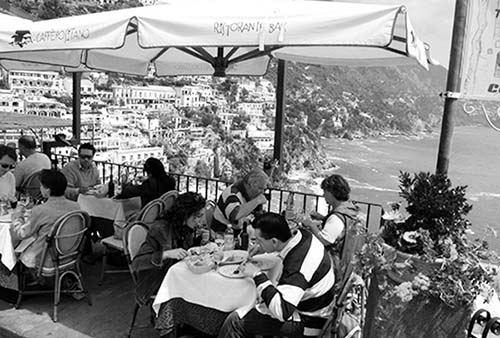
Near the Beach: A local favorite for its great views, $$$ Lo Guarracino is on the path to Fornillo Beach, with good food at prices similar to the beachfront places (daily 12:00-15:30 & 18:00-22:30, closed Nov-March, follow path behind the boat-ticket kiosks 5 minutes to Via Positanesi d’America 12, tel. 089-875-794). $$ Wine-Dark House, tucked around the base of the stairs near the beach (and the TI), fills a cute little piazzetta at the start of Via del Saracino. They serve good pastas and secondi, have a respect for wine (several excellent local wines), and are popular with Positano’s youngsters for their long list of sandwiches (Wed-Mon 10:00-15:30 & 18:30-22:30, closed Tue, Via del Saracino 6, tel. 089-811-925).
Picnics: If a picnic dinner on your balcony or the beach sounds good, sunny Emilia at the Delicatessen grocery store can supply the ingredients: antipasto misto, pastas, home-cooked dishes, and sandwiches made to order. She’ll heat it up for you and throw in the picnic ware. Come early for the best selection (all sold by weight, daily 7:00-22:00, shorter hours off-season, just below car park at Via del Mulini 5, tel. 089-875-489). Vini e Panini (a.k.a. “The Wine Shop”), another small grocery, is a block from the beach a few steps above the TI. Daniela, the fifth-generation owner, speaks English and happily makes sandwiches to order. Choose between the “Caprese” (mozzarella and tomato) and the “Positano” (mozzarella, tomato, and prosciutto), or create your own. They also have a nice selection of well-priced regional wines (daily 8:00-20:00, until 22:00 in summer, closed mid-Nov-mid-March, just behind church steps, tel. 089-875-175).
“Uptown”: The unassuming, family-run $$$ Ristorante Bruno is handy to my listed hotels on or near Via Cristoforo Colombo. While expensive, it has nice views and is worth considering if you want a meal without hiking down into the town center (daily 12:30-23:00, closed Nov-Easter, near the top of Via Cristoforo Colombo at #157, tel. 089-875-179).
After Rome fell, the town of Amalfi was one of the first to trade goods—coffee, carpets, and paper—between Europe and points east. Its heyday was the 10th and 11th centuries, when it was a powerful maritime republic—a trading power with a fleet that controlled this region and rivaled Pisa, Genoa, and Venice. The Republic of Amalfi founded a hospital in Jerusalem and claims to have founded the Knights of Malta order—even giving them the Amalfi cross, which became the famous Maltese cross. Amalfi minted its own coins and established “rules of the sea”—the basics of which survive today.
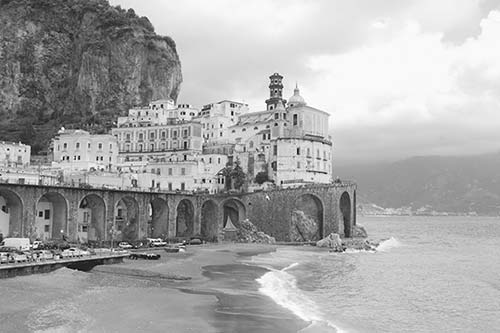
In 1343, this little powerhouse was suddenly destroyed by a tsunami caused by an undersea earthquake. That disaster, compounded by devastating plagues, left Amalfi a humble backwater. Much of the culture of this entire region was driven by this town—but because it fell from power, Amalfi doesn’t always get the credit it deserves. Today its 5,000 residents live off tourism. The coast’s namesake is not as picturesque as Positano or as well-connected as Sorrento, but it has a real-life feel and a vivacious bustle.
Though generally less touristy than Positano, Amalfi is still packed during the day with big-bus tours (whose drivers pay €80 an hour to park while their groups shop for limoncello and ceramics). Amalfi’s charms reveal themselves early and late in the day, when the crowds dissipate.
Amalfi’s waterfront is the coast’s biggest transport hub. Right next to each other are the bus station, ferry docks, and a parking lot (€5/hour; if the lot is full, park in the huge Lunarossa garage, burrowed into the hillside just past town and just before the tunnel leading into Atrani). The waterfront hub is overlooked by a statue of local boy Flavio Gioia, the purported inventor of the magnetic compass.
Amalfi’s TI is just up the main road, right before the post office and overlooking the beach (Mon-Sat 9:00-14:00 & 15:00-18:30, Nov-March Mon-Sat 9:00-14:00, closed Sun year-round, pay WC in same courtyard, Corso della Repubbliche Marinare 27—about 100 yards from the bus station and ferry dock, next to the post office; facing the sea, it’s to the left; tel. 089-871-107, www.amalfitouristoffice.it).
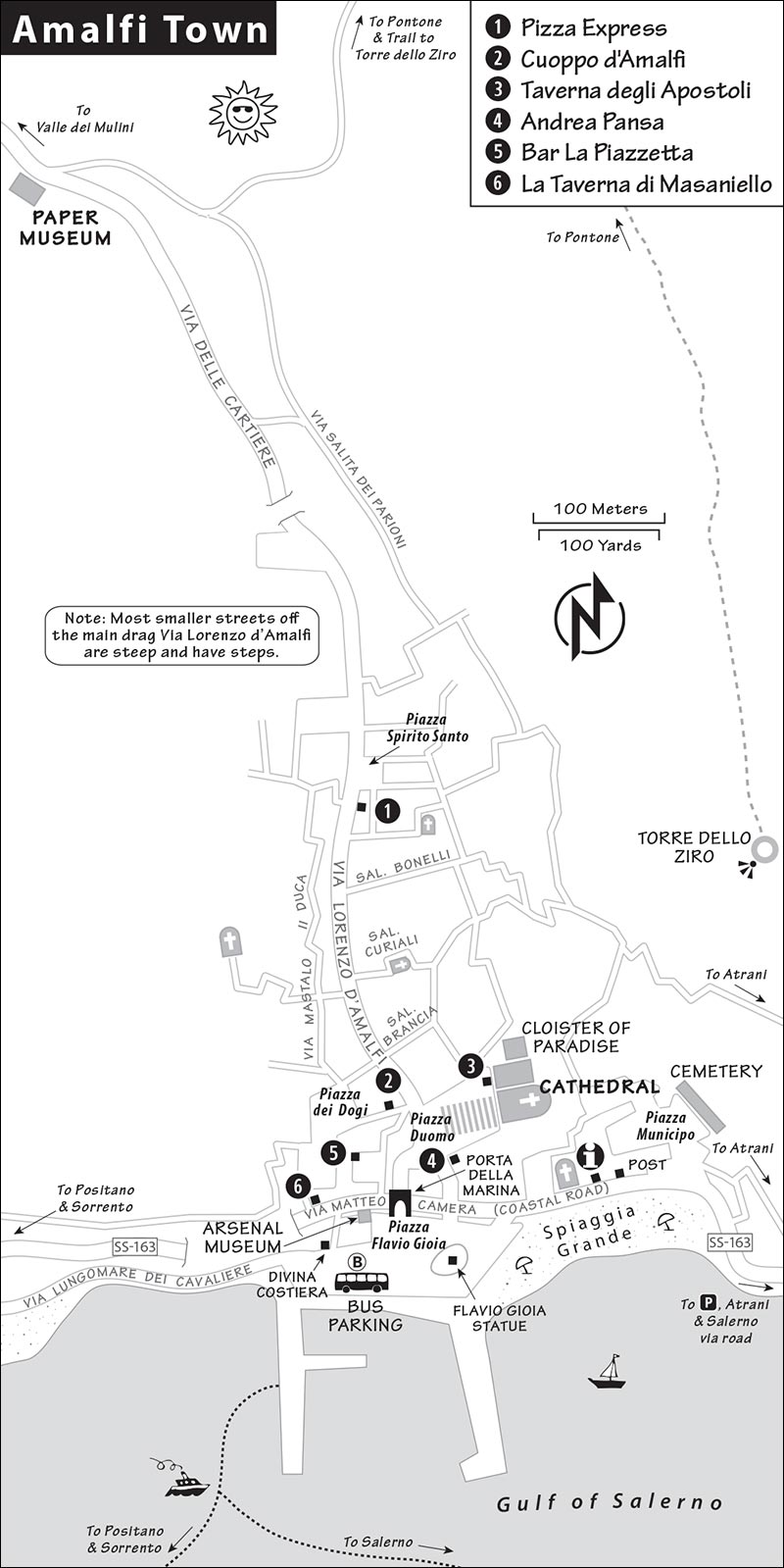
Don’t Get Stranded: If you’re day-tripping to Amalfi from elsewhere in the region, check locally to confirm when the last return bus or boat to Sorrento or Salerno leaves in the evening (in winter this can be as early as 19:00). Don’t plan to leave on the last bus or boat of the day in peak season: If that bus or boat is full, your only way home might be a €100 taxi ride.
Baggage Storage: You can store your bag safely at the Divina Costiera Travel Office facing the waterfront square, across from the bus parking area (4 hours—€5, daily 8:00-20:00, closed Feb, tel. 089-871-181).
Speedboat Charters: To hire your own boat for a tour of the coastline from Amalfi (or to Capri), consider Charter La Dolce Vita (mobile 335-549-9365, www.amalficoastyacht.it).
Amalfi’s one main street runs up from the waterfront through a deep valley, with stairways to courtyards and houses on either side. It’s worth walking uphill to the workaday upper end of town. Super-atmospheric, narrow, stepped side lanes branch off, squeezing between hulking old buildings. If you hear water under a grate in the main street, it’s the creek that runs through the ravine—a reminder that the town originally straddled the stream but later paved over it to create a main drag.
Before you enter the town, notice the colorful tile above the Porta della Marina gateway, showing off the trading domain of the maritime Republic of Amalfi. Just to the left, along the busy road, a series of arches marks the long, narrow, vaulted halls of Amalfi’s arsenal—where ships were built in the 11th century. One of these is now the little Arsenal Museum.
Venture into town, and you’ll quickly come to Piazza Duomo, the main square, with the cathedral—the town’s most important sight—and a spring water-spewing statue of St. Andrew.
As you get farther away from the water, Amalfi becomes less glitzy and more traditional. The Paper Museum is a 10-minute walk up Via Lorenzo d’Amalfi, the main drag. On the way up to the museum, don’t miss the huge, outdoor presepi (Nativity scenes) on your left. From the museum, the road narrows and you can turn off onto a path leading to the shaded Valle dei Mulini; it’s full of paper-mill ruins that recall this once proud and prosperous industry. The ruined castle clinging to the rocky ridge above Amalfi is Torre dello Ziro, a good lookout point for intrepid hikers (see “Hikes,” later).
As you return downhill, be sure to explore up the winding and narrow lanes and arcaded passages on either side of the main street.
This small, underground museum just across the road from the bus station tells a bit about Amalfi’s maritime glory years. Stepping into the single long room under the dramatic vaulted stone ceiling, you can just tell that 1,000 years ago, they made ships here.
Cost and Hours: €4, daily 10:00-14:00 & 16:00-19:30, longer hours July-Aug, Piazza Flavio Gioia, mobile 334-917-7814.
Performances: Half of the arsenal space is a venue for performances of Amalfi Musical, a 1.5-hour musical bonanza loosely based on local history (English subtitles, Wed and Sat at 21:00, no performances Nov-April, www.amalfimusical.it).
This church is “Amalfi Romanesque” (a mix of Moorish and Byzantine flavors, built c. 1000-1300), with a fanciful Neo-Byzantine facade from the 19th century. Climb the imposing stairway, which functions as a mini Spanish Steps-style hangout zone and a handy outdoor theater. The 1,000-year-old bronze door at the top was given to Amalfi by a wealthy local merchant who had it made in Constantinople. Visitors are directed on a one-way circuit through the cathedral complex with four stops: the cloister, original basilica, crypt, and cathedral.
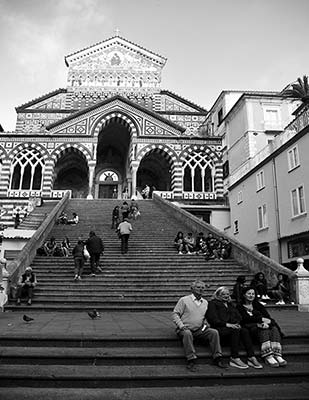
Cost and Hours: €3, daily 10:00-17:00. The cathedral—but not the rest of the complex—can be entered free for prayer or discreet visits daily 7:30-10:00 & 17:00-19:30; it’s closed 10:00-17:00 except as part of the paid visit; tel. 089-871-324, www.parrocchiaamalfi.com. There’s a fine, free WC at the top of the steps (through unmarked green door, just a few steps before ticket booth, ask for key at desk).
Visiting the Cathedral: You’ll follow a self-guided, one-way tour of the complex, beginning in a courtyard of 120 graceful columns—the “Cloister of Paradise.” This was the cemetery for nobles in the 13th century (note their stone sarcophagi). Don’t miss the fine view of the bell tower and its majolica tiles.
The original ninth-century church, known as the Basilica of the Crucifix, boasts a fine 13th-century wooden crucifix. Today the basilica is a museum filled with the cathedral’s art treasures. The Angevin Mitre (Mitra Angioina), with a “pavement of tiny pearls” setting off its gold and gems, has been worn by bishops since the 14th century. Also on display (waist-high, facing the altar) is a carved wooden decoration from a Saracen pirate ship that wrecked just outside of town in 1544 during a freak storm. The church is dedicated to St. Andrew, whom believers credit with causing the storm and saving the town from certain pillage and plunder.
Down the stairs to the right of the basilica’s altar is the Crypt of St. Andrew. Just as Venice needed St. Mark to get on the pilgrimage map, Amalfi needed St. Andrew—one of the apostles who, along with his brother Peter, left their fishing nets to become the original “fishers of men.” Under the huge bronze statue, you’ll see a reliquary holding what are believed to be Andrew’s remains (kneel at the back of the crypt for a better view). These were brought here from Constantinople in 1206 during the Crusades—an indication of the wealth and importance of Amalfi back then.
Climb the stairs up into the cathedral itself. Behind the main altar is a painting of St. Andrew martyred on an X-shaped cross flanked by two Egyptian granite columns supporting a triumphal arch. Before leaving, check out the delicate mother-of-pearl crucifix (right of door in back).
This excellent little museum—worth ▲▲▲ for paper enthusiasts—makes for a good excuse to break free from the crowds and walk up the main drag to a quieter, more local part of town. Paper has been an important industry here since Amalfi’s glory days in the Middle Ages. Millworkers would pound rags into pulp in a big vat, pull it up using a screen, and air-dry each sheet (the same technique used to make artisan paper today—look for it at shops in town). At this cavernous, cool 13th-century paper mill-turned-museum, a multilingual guide collects groups at the entrance (no particular times) for a 25-minute tour. The guide recounts the history and process of papermaking and turns on the museum’s vintage machinery. You’ll see how the Amalfi River (which you can still hear rumbling underfoot) powered this important industry, and you’ll learn the origins of the term “watermark.” Kids can dip a screen into the rag pool and make a sheet of paper. It’s amazing to think this factory produced paper through 1969 (when it was replaced by a modern facility up the valley).
Cost and Hours: €4.50; daily 10:00-18:30; Nov-Jan Tue-Sat until 15:30, closed Mon; a 10-minute walk up the main street from the cathedral—follow signs to Museo della Carta at Via delle Cartiere 23; tel. 089-830-4561, www.museodellacarta.it.
Amalfi is the starting point for several fine hikes, two of which I’ve described here. The TI hands out photocopies of Giovanni Visetti’s trail maps (or download them from his engaging website, www.giovis.com). The best book on local hikes is Julian Tippett’s Sorrento Amalfi Capri Car Tours and Walks (2015), with useful color-coded maps and info on public transportation to the trailheads. Lucia Ferrara, a great guide based in Positano, leads hikes around Amalfi (see her listing on here).
This loop trail leads up the valley past paper-mill ruins, ending in the tiny town of Pontone; you can get lunch there, and head back down to the town of Amalfi (allow 3 hours total). Bring a good map, since it’s easy to veer off the main route. Start your hike by following the main road (Via Lorenzo d’Amalfi) away from the sea.
After the Paper Museum, jog right, then left to join the trail, which runs through the shaded woods along a babbling stream. Heed the signs that warn people to stay away from the ruins of paper mills (no matter how tempting they look), since many are ready to collapse on unwary hikers. Continue up to Pontone, where Trattoria l’Antico Borgo offers wonderful cuisine and a great view (Via Noce 4, tel. 089-871-469). After lunch, return to Amalfi via a steep stairway.
If you’re feeling ambitious, before you head back to Amalfi, add a one-hour detour (30 minutes each way) to visit the ridge-hugging Torre dello Ziro (ask a local how to find the trail to this tower). You’ll be rewarded with a spectacular view.
For an easier stroll, head to the nearby town of Atrani. This village, just a 15-minute stroll beyond Amalfi town, is a world apart; its 1,500 residents consider themselves definitely not from Amalfi. Leave Amalfi via the main road and stay on the water side until the promenade ends. Cross the street, continue a few more yards, then go up the whitewashed staircase just past the pizzeria. From here, twist up through old lanes to a paved route that takes you over the hill and drops you into Atrani in about 15 minutes.
With relatively few tourists, a delightful town square, and a free, sandy beach (if you drive here, pay for parking at harbor), Atrani has none of Amalfi’s trendy resort feel. Piazza Umberto is the core of town, with cafés, restaurants, and little grocery stores that can make sandwiches. A whitewashed staircase leads up to the serene and beautiful town church (under the clock face).
To save time and sweat on the return walk, follow the promenade just above water level toward Amalfi. Then walk up through the restaurant terrace and find the big, long tunnel next to the parking garage—this will deposit you in the middle of Amalfi.
From Atrani, you could theoretically continue up to Ravello (described later in this chapter). But unless you’re part mountain goat, you’ll probably prefer catching the bus to Ravello from Amalfi town instead.
Quick Bites: Walk five minutes up the main drag; on the right, past the first archway, is $ Pizza Express, with honest pies, calzones, and heated sandwiches to go (Mon-Sat 9:00-21:00, closed Sun, Via Capuano 46, mobile 339-581-2336). The Cuoppo d’Amalfi fried-fish stand at Piazza dei Dogi (described below) is another good option.
On the Main Square, Piazza Duomo: Several pricey places face the cathedral steps. The best of the bunch is tucked just around the left side of the grand staircase, up a smaller flight of stairs: $$ Taverna degli Apostoli, with colorful outdoor tables and cozy upstairs dining room in what was once an art gallery. The menu is brief but thoughtful, going beyond the old standbys, and everything is well-executed (daily 12:00-16:00 & 19:00-24:00, Supportico San Andrea 6, tel. 089-872-991). For dessert, the Andrea Pansa pastry shop and café, to the right as you face the cathedral steps, is the most venerable place in town—a good spot to try sfogliatella (the delicate pastry invented at a nearby monastery) and other desserts popular in southern Italy (daily 7:30-24:00).
Near the Main Square, on Piazza dei Dogi: If you walk straight ahead from the cathedral stairs, go up the little covered lane, and hook right at the fork, you’ll pop out in atmospheric little Piazza dei Dogi. Slightly less trampled and more neighborhood-feeling than Piazza Duomo, this has several decent (if forgettable) restaurants aimed squarely at pleasing tourists. The $ Cuoppo d’Amalfi fried-fish shop, on the right as you enter the square, fills cardboard cones with all manner of deep-fried sea life. $$ Bar La Piazzetta has good prices at its tables right in the middle of the square. And tucked at the corner of the square leading to the port, $$ La Taverna di Masaniello is a bit pricier, with good food.
Amalfi is connected by bus and boat to all other nearby towns. If you’re coming from Salerno, buy your boat ticket directly from the booth on the dock there. Boats also connect Amalfi to Positano, Capri, and Sorrento. SITA public buses originating in either Salerno or Sorrento stop in Amalfi (some terminate here; check with driver). CitySightseeing buses, whether coming from Sorrento or Ravello, terminate in Amalfi as well. For details see “Getting Around the Amalfi Coast” on here.
The Amalfi Coast’s version of a hill town, Ravello (a 30-minute bus ride from Amalfi town) sits atop a lofty perch 1,000 feet above the sea. It boasts an interesting church, two villas with stunning gardens, and breathtaking views that have attracted celebrities for generations. Gore Vidal, Richard Wagner, D. H. Lawrence, M. C. Escher, Henry Wadsworth Longfellow, Tennessee Williams, and Greta Garbo all succumbed to Ravello’s charms and called it home.
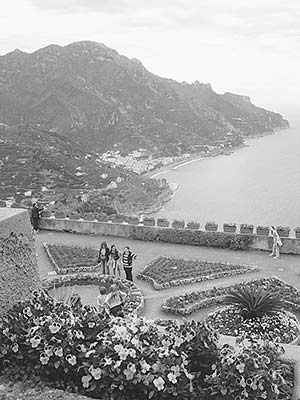
The town is like a lush and peaceful garden floating in a world all its own. It seems to be made entirely of cafés, stonework, old villas-turned-luxury hotels, tourists, and grand views. Ravello feels like a place to convalesce.
To see the sights listed here, start at the bus stop and walk through the tunnel to the main square, where you’ll find the Villa Rufolo on the left, the church on the right, and the TI down the street past the church (TI open daily 10:00-18:00, closes earlier Nov-April, 100 yards from the square—follow signs to Via Roma 18, tel. 089-857-096, www.ravellotime.com). Villa Cimbrone is a 10-minute walk from the square (follow the signs).
If you have time for only one villa, consider this: Villa Rufolo is easier to reach (facing the main square) and has a stunning terrace garden. Villa Cimbrone requires an up-and-down hike, but it’s bigger and more rugged and offers even grander views in both directions along the coast.
The town’s entry tunnel deposits you on the main square. Though Ravello is perfectly peaceful today, the weathered watchtower of Villa Rufolo—which once kept an eye out for fires and invasions—is a reminder that it wasn’t always postcards and limoncello.
The fine umbrella pines on the square provide a shady meeting place for strollers ending up here on the piazza. Opposite the church is a fine view of the terraced hillside and the community of Scala (which means “steps”—historically a way of life there). The terraces—supporting grapevines and lemon trees—mostly date from the 16th century. Viale Wagner climbs to the top of town for sea views and ruined villas that are now luxury hotels. The town is essentially traffic-free.
Ravello’s cathedral, overlooking the main square, feels stripped-down and Romanesque. The facade of the cathedral is plain because the earlier, fancy west portal was destroyed in a 1364 earthquake. The front door is locked; to enter, go through the museum on Viale Wagner, around the right side. Inside, you’ll find tastefully restrained decoration and a floor that slopes upward. The key features of this church are its 12th-century bronze doors (from Constantinople), with 54 Biblical scenes; the carved marble pulpit supported by six lions; and the chance to get a close-up look at the relic of holy blood (in the chapel left of main altar). The geometric designs show Arabic influence. The humble cathedral museum, through which you’ll enter, is two rooms of well-described carved marble that evoke the historical importance of the town.
Cost and Hours: €3 for the museum—which also gets you into the church, daily 9:00-19:00, Nov-April until 18:00.
The villa, built in the 13th-century ruins of a noble family’s palace, presents wistful gardens among stony walls, with oh-my-God views. The Arabic/Norman gardens seem designed to frame commanding coastline vistas (you can enjoy some of the same view, without the entry fee, from the bus parking lot just below the villa). It’s also one of the venues for Ravello’s annual arts festival (July-Sept, www.ravellofestival.com) and music society performances (April-June and Sept-Oct, www.ravelloarts.org). Musicians perch on a bandstand on the edge of the cliff for a combination of wonderful music and dizzying views. Wagner visited here and was impressed enough to set the second act of his opera Parsifal in the villa’s magical gardens. By all accounts, the concert on the cliff is a sublime experience.
Cost and Hours: €7, daily 9:00-20:00, Oct-April 9:00 until sunset, may close earlier for concerts, tel. 089-857-621, www.villarufolo.it.
Visiting the Villa: From Piazza Duomo, enter through the stout watchtower to buy your ticket and pick up the English booklet explaining the sight. Then, walk through part of the sprawling villa ruins. Check out the short video in the tiny theater at the base of the tower and the exhibit upstairs. The palace itself has little to show, but the gardens and views are magnificent and invite exploration.
This villa offers another romantic garden, this one built upon the ruins of an old convent. Located at the opposite end of Ravello, it was created in the 20th century by Englishman William Beckett. His mansion is now a five-star hotel. It’s a longish walk to the end of town, where you explore a bluff dreamily landscaped around the villa. At the far end, above a sublime café on the lawn, “the Terrace of Infinity” dangles high above the sea.
Cost and Hours: €7, daily 9:00-sunset, tel. 089-857-459, www.hotelvillacimbrone.com.
Getting There: Facing the cathedral on Piazza Duomo, exit the square to the right and follow signs. You’ll climb up and down (and up and down) some stair-step lanes, enjoying a quieter side of Ravello, before reaching the villa at the point.
Visiting the Villa: Buy your ticket and pick up the free map/guide of the gardens. Across from the ticket booth, duck into the old monastery. Then pass the rose-garden terrace and head up the “main boulevard,” which leads straight to the stunning Terrace of Infinity, with 360-degree views up and down the coast. If you have the interest and energy, loop back along the more rugged downhill slope (facing the adjacent town of Scala). Tiny lizards scurry underfoot, while mythological statues (Mercury’s Seat, Temple of Bacchus, Eve’s Grotto) strike their poses before a stunning and serene backdrop.
To walk downhill from Ravello’s Villa Cimbrone to the town of Amalfi (a path for hardy hikers only—follow the TI’s map), retrace your steps back toward town. Take the first left, which turns into a stepped path winding its way below the cliff. Pause here to look back up at the rock with a big white mansion—Villa La Rondinaia, where Gore Vidal lived for many years. Continue down the fairly steep path about 40 minutes to the town of Atrani, where several bars on the main square offer well-deserved refreshments. From here, it’s about a 15-minute walk back to Amalfi (see “Hike #2” on here).
Several no-brainer, interchangeable restaurants face Piazza Duomo and line the surrounding streets. To enjoy this fine setting, just take your pick. You can also grab a takeaway lunch at one of the little groceries and sandwich shops that line Via Roma (between Piazza Duomo and the TI). Enjoy your meal at the panoramic benches at the far end of Piazza Duomo (facing the cathedral), or facing even better views just outside of town, near the bus stop and Ristorante Da Salvatore. (Picnicking isn’t allowed inside the two villas.)
$$$ Ristorante Da Salvatore, near the Ravello bus stop (at the other end of the little tunnel from the Duomo), serves a serious sit-down lunch with great views. Pino, the English-speaking owner of this formal restaurant, serves nicely presented, traditional Amalfi cuisine from a fun, if pricey, menu. Their pasta with potatoes and calamari is a favorite. Be adventurous when ordering and share dishes. Pato, the parakeet, is learning English (Tue-Sun 12:30-15:00 & 19:30-22:00, closed Mon, Via della Repubblica 2, smart to call ahead for reservations—tel. 089-857-227).
Ravello and the town of Amalfi are connected by bus along a very windy road. Coming from Amalfi town, buy your bus ticket at the Divina Costiera travel office facing the waterfront square, and ask where the stop for Ravello is (normally by the statue on the waterfront, just to the statue’s left as you face the water). When returning from Ravello, line up early, since the buses are often crowded (at least every 40 minutes, 30-minute trip, €1.20, buy ticket in tobacco shop; catch bus 100 yards off main square, by the recommended Ristorante Da Salvatore). Another option to or from Ravello is a CitySightseeing shuttle bus (see “Getting Around the Amalfi Coast,” on here). Coming from Positano or Sorrento, you’ll change buses in Amalfi. From Naples or Paestum, you have to change twice (in Salerno and Amalfi), making for a long day.
The archaeological park at Paestum (PASTE-oom) includes one of the best collections of Greek temples anywhere—and certainly the most accessible to Western Europe. Serenely situated, Paestum (worth ▲▲) is surrounded by fields and wildflowers. Not quite a village, it also has a bus stop, a church, a TI, a straggle of houses, and handful of eateries.
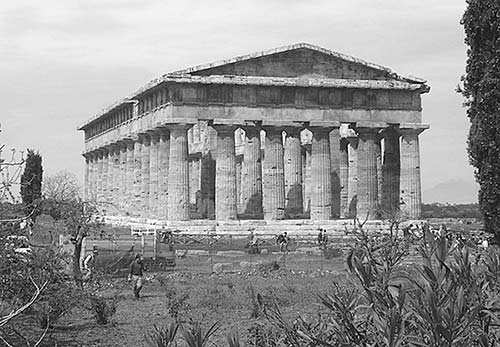
This town was founded as Poseidonia by Greeks in the sixth century BC and became a key stop on an important trade route. In the fifth century BC, the Lucanians, a barbarous inland tribe, conquered Poseidonia and tried to adopt the cultured ways of the Greeks. By the time of the Romans, who took over in the third century BC, the name Poseidonia had been simplified to Paestum. The final conquerors of Paestum, malaria-carrying mosquitoes, kept the site wonderfully deserted for nearly a thousand years. The temples were never buried—just ignored. Rediscovered in the 18th century, Paestum today offers the only well-preserved Greek ruins north of Sicily.
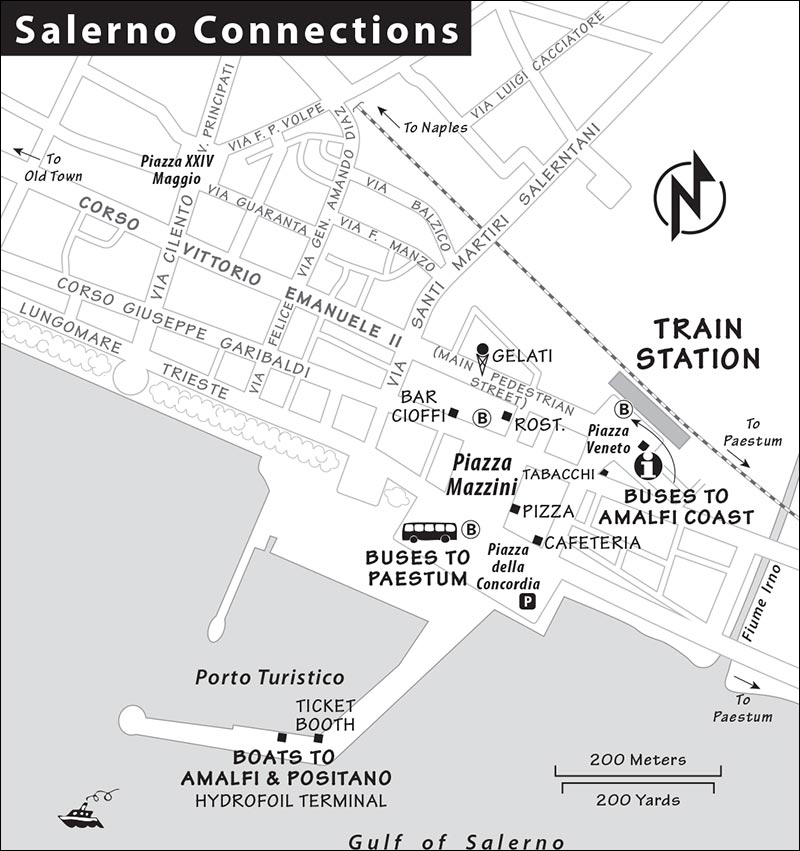
While most visitors do Paestum as a day trip (it’s an hour from Naples by convenient direct train), it’s not a bad place to overnight. Accommodations offer great value, and though it’s a bit far, you could use Paestum as a base for day trips to Naples or the Amalfi Coast. There’s a beach nearby, and hotels can help arrange visits to local buffalo-milk dairies.
Tourist Information: There’s a small TI window at the train station (daily 8:30-18:30) and a bigger one next to the Paestum Archaeological Museum (daily 9:00-13:00 & 14:00-16:00, tel. 0828-811-016, www.infopaestum.it).
Direct trains to Paestum run from Naples and Salerno; from elsewhere, you’ll need to transfer at one of those two points. For those transferring in Salerno, see the map on the opposite page, which shows train, bus, and boat stops as well as a few handy eateries if you need to grab a bite. The helpful Salerno TI can answer any questions you might have (daily 9:00-19:30).
From Naples: Direct trains run from Naples’ Centrale Station to Paestum for €7 (12/day, one hour, direction: Sapri or Reggio, only Intercity trains have a first-class section). Buy tickets online, or from the ticket windows or machines at the station. For a day trip from Naples, it’s wise to get an early start—especially in warm weather. As of this printing, trains left Naples at 6:50, 7:35, 7:55, and 8:50, then not until 11:45 (confirm schedule on www.trenitalia.it). In the cooler shoulder season, consider arriving for lunch, visiting the museum, then seeing the temples bask in warm afternoon light.
From Amalfi Town: First take a bus (75 minutes) or boat (35 minutes) to Salerno, where you can catch the train on its way from Naples (30 minutes from Salerno to Paestum). You’ll need to leave Amalfi early—8:00 at the latest—to make the last morning train. Buses from Amalfi terminate at the Salerno train station, but if you arrive in Salerno by boat, you’ll walk from the boat dock a few short blocks up to the train station (about 10 minutes, mostly level; see map). Once in Salerno, buy your Paestum train ticket at ticket machines or the ticket office in the train station.
If you’re in a pinch—for example, you’ve arrived in Salerno during the midday lull in the train schedule—you could take local CSTP/BusItalia bus #34 from Salerno to Paestum (about hourly, fewer on Sun, one-hour trip). It seems convenient to the port (it departs from Piazza della Concordia—look for bus shelter between the big parking lot and the main road, no posted schedule), but you can’t buy tickets nearby—the closest sales point is the tobacco shop a block in front of the train station. In Paestum, this bus drops you only slightly closer to the ruins than does the train.
From Positano: The extra 50 minutes by road to Amalfi, plus time spent changing buses there, makes a day trip from Positano to Paestum more difficult than from Amalfi town. It’s possible, though (take a crack-of-dawn bus to Amalfi or the first ferry of the day to Salerno), especially in summer, when return buses from Amalfi run until late in the evening.
From Sorrento: The smart (if dull) approach is to go by Circumvesuviana train to Naples (70 minutes), catch the direct Naples-Paestum train, and return the same way. While it’s technically possible to do one leg of the trip via an Amalfi Coast bus, this makes for a very long day marred by worry about making connections back. Other options are to rent a car or hire a taxi for the day. From Sorrento, Paestum is 60 miles and at least 3 hours (depending on traffic) via the Amalfi Coast road, but a smooth 2 hours by autostrada. To reach Paestum from Sorrento via the autostrada, drive toward Naples, catch the autostrada (direction: Salerno), skirt Salerno (direction: Reggio), exit at Battipaglia, and drive straight through the roundabout.
If you drive to Paestum, you’ll see signs for mozzarella di bufala, cheese made from the milk of water buffalo. Try it here—it couldn’t be any fresher.
Arrival at Paestum: If you arrive by train, cross under the tracks, exit the tiny station, and walk through the ancient city gate; the ruins are a half-mile walk straight ahead, up a dusty road. When you hit the street with hotels and shops, turn right to find the museum and site entrance. If you’d rather not walk, Patrizia Pecora runs a great team of local taxi drivers available for transport to hotels or to the ruins (€10 fixed rate, mobile 392-444-9020). Buses from Salerno stop near a corner of the ruins (at a little bar/café).
There’s no official baggage storage at the train station or museum. If you’re desperate, you can try nicely asking at one of the bars along the main road (they may want a small payment) or ask at a restaurant you’ve already patronized.
Cost: €9, €10 with special exhibits, includes site and museum. The site alone is €7 on days when the museum is closed; the museum alone is €4 after dark on winter evenings, when the site is closed.
Hours: Museum open Tue-Sun 8:30-19:30 (last ticket sold at 18:50), closed Mon. Site open daily 8:30 to one hour before sunset (as late as 19:30 June-July, as early as 16:00 in late Nov-Dec, last site ticket sold 40 minutes before closing).
Information: Tel. 0828-811-023, www.museopaestum.beniculturali.it [URL inactive].
Getting In: The site and museum have separate entrances. The museum, just outside the ruins, is in a cluster with the TI and a small early-Christian basilica. Most visitors buy tickets at the museum and use the entrance across the street, but another ticket office and entrance are near the recommended Ristorante Nettuno (at the south end of the site). On days when the museum is closed, tickets are sold only at the site entrances.
Local Guide: For an insider’s knowledge, Silvia Braggio specializes in Paestum and gives a fine two-hour walk of the site and museum (special rate for my readers—€100, arrange in advance, mobile 347-643-2307, www.silviaguide.it, silvia@silviaguide.it). She also offers walking tours of Pompeii and Herculaneum.
Eating: Several cafés and bars cluster around the museum (all open long hours daily in summer). $ La Basilica Café, facing a pretty little garden between the parking lot and TI, is the most straightforward and reasonable option, with good pizzas and other lunch fare (Via Magna Grecia 881, tel. 0828-811-301). Ristorante Nettuno, with standard tourist food and good temple views, is at the site’s south entrance. They have a fine little glassed-in $$ café facing the ruins and a dressier, more expensive $$$ restaurant across the path (Via Nettuno 2, tel. 0828-811-028).
Another cluster of restaurants and bars sits north of the ruins, just outside the city wall along Via Tavernelle (a short walk from the museum). Away from the main entrance crowds, this strip of elegant eateries offers a good way to enjoy Paestum’s peaceful atmosphere. $$$ Bistrot 73, run by hard-working chefs Roberto and Manuela, serves wonderful pasta dishes in a playful but sophisticated setting (at #48, mobile 342-526-1393). $$ GinGin serves regional wines and snazzy cocktails (at #38, open from 19:00, mobile 392-872-3016). $$$ Antiche Mura accompanies their fine grilled meats with an impressive wine list (at #20, tel. 0828-199-8535).
Length of This Tour: Allow two hours to see the ruins and the museum (about an hour for each). Which one you see first depends on your interest and the heat: You’ll enjoy the coolest temperatures in the morning, but the best light and smallest crowds late in the day.
While Paestum is famous for its marvelous Greek temples, most of the structures you see are Roman. Five elements of Greek Paestum survive: three misnamed temples, a memorial tomb, and a circular meeting place (the Ekklesiasterion). The rest, including the wall that defines the site, is Roman.
Paestum was once a seaport (the ocean is now about a mile away—the wall in the distance, which stretches about three miles, is about halfway to today’s coastline). Only about a fifth of the site has been excavated. The Greek city, which archaeologists figure had a population of about 13,000, was first conquered by Lucanians (distant relatives of the Romans, who spoke a language related to Latin), and then by the Romans (who completely made it over and built the wall you see today).
The remaining Greek structures survive because the Romans were superstitious—they respected sacred areas and didn’t mess with temples and tombs. While most old Christian churches are built upon Roman temples (it tends to be what people do when they conquer another culture), no Roman temple is built upon a Greek temple. The three Greek temples that you’ll see here today have stood for about 2,500 years.

 SELF-GUIDED TOURS
SELF-GUIDED TOURSAlthough there are only scant descriptions at the site, the following self-guided tours provide all the information you need for both the site and the museum. Skip the museum bookshop’s dull audioguide.
This part of the tour starts at the entrance by the museum, visits the Temple of Ceres, goes through the center of the Roman town past the Greek Memorial Tomb, circles around the other two Greek temples, and then leaves the site to walk down the modern road to the Ekklesiasterion (which faces the museum).
• Buy your ticket at the museum, then head to the right to find the site’s north entrance. Once inside, stand in front of the...
Temple of Ceres: All three Paestum temples have inaccurate names, coined by 19th-century archaeologists who based their “discoveries” on wishful thinking. (While the Romans made things easy by leaving lots of inscriptions, the Greeks did not.) Those 1800s archaeologists wanted this temple to be devoted to Ceres, the goddess of agriculture. However, all the little votive statues found later, when modern archaeologists dug here, instead depicted a woman with a big helmet: Athena, goddess of wisdom and war. (The Greeks’ female war goddess was also the goddess of wisdom—thinking...strategy...female. The Romans’ masculine war god was Mars—just fighting.) Each temple is part of a sanctuary—an open, sacred space around the temple. Because regular people couldn’t go into the temple, the altar logically stood outside.
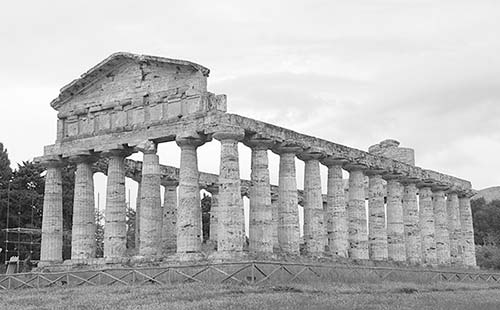
The Temple of Ceres dates from 500 BC. It’s made of locally quarried limestone blocks. Good roads and shipping didn’t come along until the Romans, so the Greeks’ buildings were limited to local materials. The wooden roof is long gone. Like the other two temples, this one was once painted white, black, and red, and has an east-west orientation—facing the rising sun. This temple’s cella (interior room) is gone, cleared out when it was used as a Christian church in the sixth century. In medieval times, Normans scavenged stones from here; chunks of these temples can be found in Amalfi’s cathedral.
Walk around to the back side of the Temple of Ceres. The capitals broke in a modern earthquake, so a steel bar provides necessary support. Each of the Paestum temples is Doric style—with three stairs, columns without a base, and shafts that narrow at the top to a simple capital of a round, then a square, block. While there were no carved reliefs, colorful frescoes once decorated the pediments.
As you walk away, look back at the temple. Traditionally, Greeks would build a sanctuary of Athena on a city’s highest spot (like the Parthenon in Athens, on the Acropolis). Paestum had no hill, so the Greeks created a mound. The hill was more impressive in its time because the level of the Greek city was substantially lower than the Roman pavement stones you’ll walk on today.
• Follow the path down from behind the temple, and turn left to walk on the paving stones of Via Sacra toward the other Greek temples. After about 100 yards, to the left of the road, you’ll see a little half-buried house with a tiled roof.
Greek Memorial Tomb (Heroon): This tomb (from 500 BC) also survived because the Romans respected religious buildings. But the tomb was most inconveniently located, right in the middle of their growing city. So the practical Romans built a perimeter wall around it (visible today), added a fine tiled roof, and then buried the tomb.
There’s a mystery here. Greeks generally buried their dead outside the city (as did Romans)—there are over a thousand ancient tombs outside Paestum’s walls—yet this tomb was parked smack-dab in the center of town. When it was uncovered in 1952, no bodies were found inside. The tomb instead held nine perfectly preserved vases (now in the museum). Archaeologists aren’t sure what the tomb’s purpose was. Perhaps it was a memorial dedicated to some great hero (like a city founder). Or perhaps it was a memorial to those lost when a neighboring community had to evacuate and settle as refugees here.
• Continue walking down Via Sacra, the main drag of...
Roman Paestum: Roman towns were garrison towns: rectangular with a grid street plan and two main streets cutting north-south and east-west, dividing the town into four equal sections. They were built by military engineers with a no-nonsense standard design. New excavations (on the left) have uncovered Roman-era lead piping. City administration buildings were on the left, and residential buildings were on the right.
Shortly after the road turns into a dirt path, you’ll come to a big Roman pool (on the left) that archaeologists believe was a sanctuary dedicated to Fortuna Virilis, goddess of luck and fertility. The strange stones likely supported a wooden platform for priests and statues of gods. Imagine young women walking down the ramp at the far end and through the pool, hoping to conceive a child.
The next big square on the left was the Roman forum and ancient Paestum’s main intersection. The road on the right led directly (and very practically) to the port. It made sense to have a direct connection to move freight between the sea and the center of town.
Until 2007, the vast field of ruins on the right (between the forum and the next temple) was covered in vegetation. It’s since been cleared and cleaned of harmful lichen, which produce acids that dissolve limestone. Study the rocks: Yellow lichen is alive, black is dead. Even the great temples of Paestum were covered in this destructive lichen until 2000, when a two-year-long project cleaned them for the first time.
• Ahead on the left are the so-called...
Temple of Neptune and Hera: The Temple of Neptune dates from 450 BC and employs the Greek architectural trick where the base line is curved up just a tad to overcome the illusion of sagging caused by a straight base. The Athenians built their Parthenon (with a similar bowed-up base line) just 30 years after this. Many think this temple could have been their inspiration.
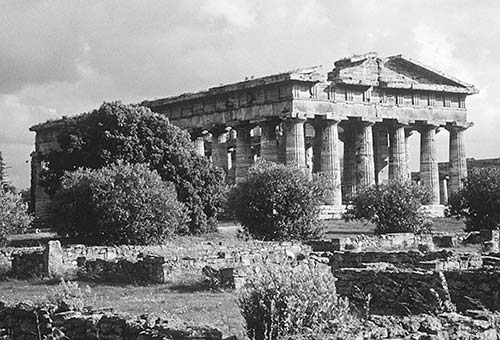
The adjacent Temple of Hera, dating from 550 BC, is the oldest of Paestum’s three temples and one of the oldest Greek temples still standing anywhere. Notice the change 100 years makes in the architectural styles: Archaic Doric in 550 BC versus Classic Doric in 450 BC.
Archaeologists now believe the “Temple of Neptune” was actually devoted to a different god. Votive statues uncovered here suggest that Hera was the focus (perhaps this was a new-and-improved version of the adjacent, simpler, and older Temple of Hera). Or perhaps it was a temple to Zeus, Hera’s husband, to honor the couple together.
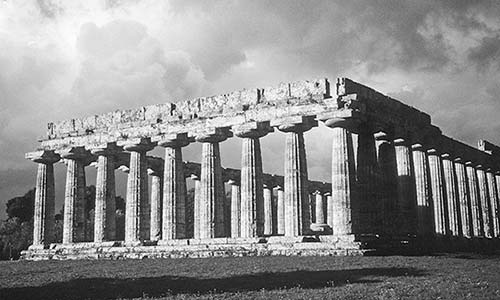
Together, the two temples formed a single huge sanctuary with altars on the far (east) side. Walk between the temples, then hook right to get a good look at the front of the Temple of Hera. Notice how overbuilt this temple appears. Its columns and capitals are closer together than necessary, as if the builders lacked confidence in their ability to span the distance between supports. Square pillars mark the corners of the cella inside. Temples with an odd number of columns (here, nine) had a single colonnade crossing in the center inside to support the wooden roof. More modern temples (such as the Temple of Neptune) had six columns, with two colonnades passing through the cella. This left a line of vision open through the middle so that worshippers could see the big statue of the god.
By the way, in 1943, Allied paratroopers dropped in near here during the famous “Landing of Salerno,” when the Allies (who had already taken Sicily) invaded mainland Italy. Paestum was part of their first beachhead. The Temple of Hera served as an Allied military tent hospital. From here, the Allies pushed back the Nazis, marching to Naples, Cassino, and finally to Rome.
• Leave the site (using the exit straight ahead from the Temple of Neptune and a bit to the left) and turn left on the modern road...
Via Magna Grecia: The king of Naples had this Naples-to-Paestum road built in 1829 to inspire his people with ancient temples. While he was modern in his appreciation of antiquity, his road project destroyed a swath of the ancient city, as you’ll see as you pass by half of the small amphitheater.
• Just past the amphitheater, you’ll find the...
Ekklesiasterion: Immediately across the street from the museum is what looks like a sunken circular theater. This rare bit of ancient Greek ruins was the Ekklesiasterion, a meeting place where the Greeks would get together to discuss things and vote. Archaeologists believe that the agora (market) would also have been located here.
• Across the street is the...
Paestum’s museum offers the rare opportunity to see artifacts—dating from prehistoric to Greek to Roman times—at the site where they were discovered. These beautifully crafted works (with good English descriptions throughout) help bring Paestum to life. Not everything you see here is from Paestum, though, as the museum also collects artifacts from other nearby sites.
Before stepping into the museum, notice the proud fascist architecture meant to imitate the structure of the temples you’ve just seen. Though the building dates from 1954, it was designed in 1938. It seems to command that you will enjoy this history lesson.
The exhibit is on several levels. You’ll find mostly Greek pieces on the ground floor (artifacts from the Temple of Hera in front, frescoes from tombs in the back), Paleolithic to Iron Age artifacts on the mezzanine level, and Roman art on the top floor (statues, busts, and inscriptions dating from the time of the Roman occupation). While Roman art is not unique to Paestum, the Greek collection is—so that’s what you should focus on.
• Before exploring the collection, notice the display case (tucked into the far-right corner near the entrance) with the huge book turned to a page with a fine drawing by the Italian artist Giovanni Piranesi, showing his visit to Paestum in 1777. Then look for these museum highlights.
Temple Reliefs: The museum’s center room is designed like a Greek temple inner cella and used for temporary exhibitions. The large carvings overhead (known as metopes) that wrap around this inner sanctum once adorned a sanctuary of the goddess Hera five miles away. This sanctuary, called Heraion del Sele, was discovered and excavated in 1934. Some of the carvings show scenes from the life of Hercules. You’ll get a chance to see the details later in this visit.
• Along the back wall of this room, find the glass case holding nine perfectly preserved...
Vases: One ceramic and eight bronze, with artistic handles, these vases were found in Paestum’s Greek Memorial Tomb. Greek bronzes are rare because Romans often melted them down to make armor. These were discovered in 1952, filled with still-liquid honey and sealed with beeswax. The honey (as you can see in the display cases below) has since crystallized. Honey was a standard part of a funeral because, to ancient Greeks, honey symbolized immortality...it lasts forever.
• Enter the room at the far end of the main hall, filled with ancient Greek...
Votive Offerings: These were dug up at Heraion del Sele (not at Paestum) like the temple reliefs seen earlier. Such offerings are a huge help to modern archaeologists, since the figures that worshippers brought to a temple are clues as to which god the temple honored. These votives depict a woman with a crown on a throne—clearly Hera. The clay votives were simple, affordable, and accessible to regular people.
• Now continue ahead into the large room (broken up by pillars and interior walls) that holds...
Relics from the Temples at Paestum: This room displays smaller pieces. Displays tell in which temple each relic was found (videos unfortunately are only in Italian). The Temple of Ceres is often referred to as the Temple of Athena or as the northern (settentrionale) sanctuary. The Temples of Neptune and Hera are spoken of as the southern (meridionale) sanctuaries.
In a glass case nearby, find the seated statue of Zeus. This painted clay Zeus dates from 520 BC. The king of the gods was so lusty with his antics, he’s still smirking.
Farther into the room, you can’t miss the display case of a statue’s torso emblazoned with swastikas—a reminder that this symbol (carrying completely different meanings) predated Hitler by millennia.
Across the room, look for the short fragment of a frieze with lion heads. Paestum’s three temples were once adorned with decorations, such as these ornamental spouts that spurted rainwater out of lions’ mouths. Notice the bits of the surviving black, red, and white paint. Reconstructions on the adjacent wall show archaeologists’ best guesses as to how the original decorations might have looked.
• Look out the museum’s back window for a good, if distant...
View of Paestum’s Walls: The walls of ancient Paestum reach halfway to the mountain—a reminder that most of the site is still private property and yet to be excavated. The town up on the mountainside is Capaccio, established in the eighth century when inhabitants of the original city of Paestum were driven out by malaria and the city was abandoned.
• Walk along the corridor at the back of the museum, which shows...
Objects from Tombs: More than 1,000 tombs have been identified outside the ancient city’s wall. About 100 were found decorated with frescoes or containing objects such as these.
• At the far end of the corridor, turn left to see...
The Tomb of the Diver: This is the museum’s treasure and the most precious Paestum find. Dating from 480 BC, it’s not only the sole ancient Greek tomb fresco in the museum—it’s the only one ever found in southern Italy. Discovered in 1968, it has five frescoed slabs (four sides and a lid; the bottom wasn’t decorated). The Greeks saw death as a passage: diving from mortality into immortality...into an unknown world. Archaeologists believe that the pillars shown on the fresco represent the Pillars of Hercules at Gibraltar, which in ancient times defined the known world. The ocean beyond the Mediterranean was the great unknown...like the afterlife. The Greek banquet makes it clear that this was an aristocratic man.
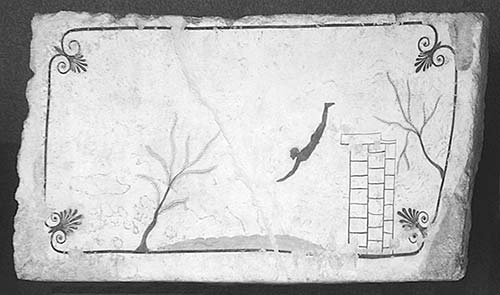
• After the Tomb of the Diver, the next room displays...
Lucanian Tomb Frescoes: The many other painted slabs in the museum date from a later time, around 350 BC, when Paestum fell under Lucanian rule. These frescoes are cruder than their earlier Greek counterpart. The people who conquered the Greeks tried to appropriate their art and style, but they lacked the Greeks’ distinctive light touch. Still, these offer fascinating glimpses into ancient life here at Paestum.
• Beyond this room, you’ll find yourself back at the entrance. Before you leave, go up the stairs by the bookshop for a glimpse at the mezzanine level, which focuses on prehistoric archaeology. Also see the temple friezes at eye level now, with explications of what’s happening in almost every scene. Near the end of the left hall, check out the...
Film Footage from WWII: A 10-minute continuous film loop, subtitled in English, tells the story of Allied soldiers’ encounters with the ruins in 1943. You’ll see footage of soldiers hanging up their laundry and shaving in the temples, which they actually safeguarded well. Part of the film focuses on excavations directed by a British archaeologist who was attached to the invading forces.
• The back wall of the mezzanine displays bronze vases, mostly from Gaudo, a half-mile from Paestum.
Paestum at night, with views of the floodlit ruins, is magic. Accommodations here offer great value. You can sleep in a mansion for the same price you’d pay for a closet in Positano. All listings have free parking.
$$ Hotel Villa Rita is a tidy, quiet country hotel set on two acres within walking distance of the beach and the temples. It has 22 rooms, a kid-friendly swimming pool, and attractive grounds with grassy lawns and a little soccer field (RS%, air-con, lunch or dinner available, closed Nov-mid-March, Via Nettuno 9, tel. 0828-811-081, www.hotelvillarita.it, info@hotelvillarita.it, Luigi). The hotel is a 10-minute walk west of the Hera entrance and public bus stop, and a 20-minute walk from the train station (they can usually pick you up if you’re arriving with luggage).
$ Il Granaio dei Casabella, a converted old granary with 14 attractive, reasonably priced rooms, is a 10-minute walk from the ruins. It has a beautiful garden and pretty common areas, and four rooms have temple views (RS%, family rooms, air-con, closed Dec-Feb, just west of the bus stop closest to Salerno at Via Tavernelle 84, tel. 0828-721-014, www.ilgranaiodeicasabella.com, info@ilgranaiodeicasabella.com, hospitable Celardo family).
$ Hotel delle Rose, with 10 small, basic rooms with minuscule bathrooms, is near the Neptune entrance on the street bordering the ruins. It’s an acceptable choice for those on a budget and is also the option closest to the ruins and the train station (RS%, family rooms, air-con, Via Magna Grecia 179, tel. 0828-189-0778, www.hotelristorantedellerose.com, info@hotelristorantedellerose.com, Luigi).
Outside Town: A great option for drivers, $$ Agriturismo Seliano has plush public spaces, a pool, and 14 grand, spacious rooms on a peaceful, once-elegant farm estate that’s been in the same family for 300 years (air-con, closed Nov-March; one mile north of ruins on main road—Via Magna Grecia—a small Azienda Agrituristica Seliano sign directs you down long dirt driveway; Via Seliano, tel. 0828-723-634, www.agriturismoseliano.it, seliano@agriturismoseliano.it). They serve a fine lunch or dinner for guests and nonguests—made with produce fresh from the garden—and can also organize cooking classes. The place is run by Cecilia—an English-speaking baroness—and her family, including about a dozen nice and friendly dogs.
By Train: A dozen slow, milk-run trains per day head to Salerno (30 minutes) and Naples (one hour). In Salerno, you can change for the bus to Amalfi or walk down to the harbor to catch an Amalfi- or Positano-bound boat. You can buy train tickets at machines in the (unstaffed) Paestum station.
By Bus to Salerno: Buses depart from Paestum to Salerno roughly every hour (fewer on Sun; one-hour trip). Buy a ticket from one of the bars in Paestum, then go to either of the intersections that flank the ruins (see the “Paestum” map), flag down any northbound bus, and ask, “Salerno?” From Salerno, you can continue on to Amalfi or Positano by boat or walk up to the train station to catch an Amalfi-bound SITA bus or a train.